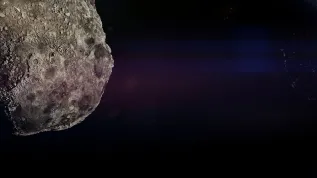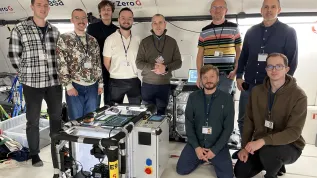
How do astronauts' soft tissues adapt to space conditions and changes resulting from the process of preparing for the mission? Polish researchers will investigate this as part of an experiment during the IGNIS mission. Diagnostics are carried out with the use of AI.
Astro Performance (Mollis Textus) is one of 13 experiments in the Polish technological and scientific mission IGNIS to the International Space Station (ISS). The launch of the Ax-4 crew - with the Polish European Space Agency (ESA) project astronaut Sławosz Uznański-Wiśniewski, has been announced for 'no earlier than May'.
The main goal of the Astro Performance (Mollis Textus) experiment is to assess the impact of a space mission on the musculoskeletal system, especially on the soft tissues of astronauts.
"'When I think about a space mission, I mean both the impact of microgravity, which in this case will be limited to a two-week stay on the ISS, and the entire preparations plus the subsequent period of convalescence. Remember that not only the mission itself, but also this period of very active preparation is a huge stress for the astronauts' musculoskeletal system, which is why various aspects of it, e.g. efficiency and general condition, may be subject to degradation', says the experiment coordinator, Norbert Kapiński, PhD, from Smarter Diagnostics - a spin-off company of the University of Warsaw.
He emphasises that researchers use artificial intelligence methods to interpret diagnostic data.
'In the future, our results are expected to contribute to the optimisation of the preparation protocol for astronauts - or even space tourists - for this type of expedition', he adds.
On a daily basis, Norbert Kapiński - together with the other co-founder of the company, Bartosz Borucki - works on practical applications of artificial intelligence algorithms, focusing on the musculoskeletal system. 'We combine various data that are important for monitoring the functioning of this system. We use radiological images (MRI), blood test results, body composition, and functional assessments. All these aspects affect the functioning of our musculoskeletal system', he says.
Then, researchers interpret these data using large neural networks. 'With modern methods, we can find certain non-obvious patterns in a broad context of data, and interpret them in a personalised manner, for a specific person. On this basis, we determine the best possible motor preparation, diet, and supplementation regimens, e.g. for athletes', Kapiński explains.
The researchers have already collected such data from two Ax-4 crew members. The tests took place in and near Warsaw in February 2025. 'We examined the astronauts holistically, the entire process took almost 8 hours. Finding this amount of available time in the tight schedule of astronauts was a challenge', he says.
He adds that a similar examination will be carried out after the mission is completed. 'After a few weeks, months at most, the astronauts should return to their previous form. We will measure whether this is the case', he says.
The collected data are now being analysed. 'There is quite a lot of data, and besides, we collect them in a very extensive protocol', the researcher emphasises.
The results will be compared with the analyses of the reference group of 10 people who are physiologically similar to astronauts (in terms of race, gender, biological and chronological age) and who take good care of their musculoskeletal system.
Why is this experiment important? According to the researcher, 'the number of people sent into space is growing every year. Considering the plans to build new, commercial space stations, a base on the Moon, and someday on Mars, this number will grow even more. These people will have to be prepared for such challenges. Not everyone will be as physically good a candidate as today's astronauts, hence the need for tools that will interpret certain medical and non-medical data quite quickly and help us prepare better - in this case, in the context of the musculoskeletal system', Kapiński says.
When asked about the circumstances that encouraged him to apply in the competition for experiments as part of the Polish mission, he replies that the company had already been thinking about expanding the scope of their research, for example, to uniformed services or astronauts.
'Shortly after that, it was announced that Uznański-Wiśniewski was a preliminary candidate for a space mission. I took the liberty of contacting him via social media and asked if this type of project would be interesting. He replied briefly that it would be possible and sent a link to the application. And so we ended up as one of the chosen thirteen', Norbert Kapiński says.
He adds that he is also personally motivated to work on this experiment, because one of his dreams is to see at least the curvature of the Earth from space.
The Ax-4 mission will be a commercial manned expedition carried out by Axiom Space. The Polish astronaut's participation is the result of an agreement signed between the Polish Ministry of Development and Technology and ESA to prepare and conduct the Polish scientific and technological mission IGNIS to the ISS. As the executive agency of the Ministry of Development and Technology, the Polish Space Agency (POLSA) also takes part in the preparations.
The Ax-4 crew members are Peggy Whitson (USA) - commander; Sławosz Uznański-Wiśniewski (Poland/ESA) - specialist; Shubhanshu Shukla (India) - pilot and Tibor Kapu (Hungary) - specialist. The launch is officially scheduled no earlier than May; unofficially it will most likely take place at the turn of June. The astronauts will fly to the ISS on the SpaceX Falcon 9 rocket, which will carry the Dragon spacecraft into orbit from NASA's Kennedy Space Center in Florida. The astronauts will spend 14 days on the International Space Station. (PAP)
PAP - Science in Poland, Agnieszka Kliks-Pudlik
akp/ zan/ ktl/













